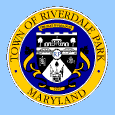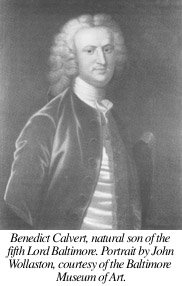
The Eighteenth Century Calvert Residence in Annapolis
|
Global Navigation Links
Local Navigation Links
|
by Margaret Law Callcott
A recent book by Anne Elizabeth Yentsch, A Chesapeake Family and Their Slaves: A Study in Historical Archeology (Cambridge University Press, 1994), contains a great deal of information, hitherto unknown, about the Calvert family of Maryland and of Riversdale. The "Chesapeake Family" that Yentsch writes about lived on State Circle in Annapolis--where the Calvert House Hotel now stands--and included the grandparents and parents of George Calvert of Riversdale.
This is primarily a book about archeology, but it is archeology supplemented with a well-documented historical record. The author divides the book into chapters on the archeology of the site and chapters on its history. The archeological chapters tend to be overly long and weighed down with sociological commentary. The historical chapters are scattered throughout the book; consequently, the reader has to search all over to construct a clearly delineated chronology of the site's history, its occupants and its structural changes. But this is where the exciting new information about the Calvert family is buried and the effort is worthwhile.
When investigation begins, all that researchers knew about the Calvert House site was that it was the probable residence of a colonial governor of Maryland. What was uncovered and documented was a Calvert family compound which housed not one but two Calvert governors of the Maryland colony who lived in great splendor--for a few years at least. The house also served as the residence of young Elizabeth Calvert (mother of George Calvert of Riversdale) and the first home of Elizabeth and her cousin Benedict Calvert when they married.
Calvert occupancy of the site began in 1728 when Captain Charles Calvert who had served as Governor of the Maryland colony bought an existing house and moved in. Captain Calvert had been sent in 1720 to govern the colony by his young cousin of the same name, the Fifth Lord Baltimore. The Captain had had only moderate success in administering the colony and was in the process of being replaced by the Fifth Lord's younger brother, Benedict Leonard Calvert, when he purchased the State Circle house. Captain Calvert had achieved more success on a personal level when in 1722 he married 16-year-old Rebecca Gerard, an only child and heiress to substantial land-holdings in Prince George's County. The Captain and Rebecca had several children but only Elizabeth, born in 1730, survived.
The author believes that Captain Calvert bought the house on State Circle not as a townhouse for his immediate family's use but as an extended Calvert family site. The Captain's main residence was his tobacco farm in Prince George's County, land acquired by him through his wife's inheritance and land which would eventually pass on to his grandson George Calvert of Riversdale--a holding christened "Mount Albion" by Rosalie Calvert. The Captain knew he was being replaced by Benedict Leonard and that another of the Lord's younger brothers, Edward Henry, was coming to assist. Edward Henry was accompanied by his wife Margaret. The Captain made improvements to the house in anticipation of the new Governor's arrival and purchased additional lots to expand the site.
When Governor Benedict Leonard Calvert settled into the Annapolis house, even more extensive improvements were undertaken and the house reached its peak during the early 1730s. Wooden portions of the house were replaced with brick, new fireplaces and chimneys installed, several additions and expansions made to the structure, an orangerie heated by an underground brick hypocaust was constructed, terraced gardens were laid out, and there is archeological evidence that peacocks strolled in the gardens. Probate inventories show a superbly equipped kitchen--equal to that of the Governor's Palace in Williamsburg in 1760--and extensive use of imported porcelain, silver, and crystal in the Calvert house.
Credit for making the house such a showplace and a powerful statement of the Calvert presence in the colony goes to Benedict Leonard who was broadly educated and widely traveled. He and his older brother, the Fifth Lord, had traveled in France to-gether, visiting Versailles and its gardens which made an indelible impression on both young men. The Fifth Lord came home from that trip and began a massive renovation of his mansion and gardens in Surrey County, Woodcote Park. Benedict Leonard also toured Italy before he came to Maryland and delighted in its classicism, its architecture, and its gardens. Benedict Leonard was not happy about leaving England and living in Maryland which he described as "this unpolished part of the universe," but he would serve his brother and make the best of a bad situation by ordering both his residence and the colony to his liking.
In 1732-33, Charles Calvert, Fifth Lord Baltimore, paid a visit to his colony--the first Lord Proprietor since 1684 to do so, and indeed the last to come to these shores. He came to his Annapolis capital, of course, and while there is not documentary evidence that he and Lady Baltimore stayed at the house on State Circle, it is a reasonable assumption that they did.
 Illness and death also visited the Annapolis Calvert house in the 1730s. Edward Henry Calvert died there in 1730 and his widow Margaret returned to England. Benedict Leonard had never been in good health and the Maryland climate aggravated his condition. He resigned his post in 1731 and set sail for home in 1732, but died before the voyage was completed. Captain Charles Calvert died in 1734, followed shortly by his wife Rebecca. This left the Annapolis Calvert house in the hands of five-year-old Elizabeth Calvert who had been left in the care of a minor Venetian nobleman living in Annapolis, Onorio Razolini, and his wife. The Razolinis served as tutors and foster parents to the orphaned Elizabeth for the next thirteen years.
Illness and death also visited the Annapolis Calvert house in the 1730s. Edward Henry Calvert died there in 1730 and his widow Margaret returned to England. Benedict Leonard had never been in good health and the Maryland climate aggravated his condition. He resigned his post in 1731 and set sail for home in 1732, but died before the voyage was completed. Captain Charles Calvert died in 1734, followed shortly by his wife Rebecca. This left the Annapolis Calvert house in the hands of five-year-old Elizabeth Calvert who had been left in the care of a minor Venetian nobleman living in Annapolis, Onorio Razolini, and his wife. The Razolinis served as tutors and foster parents to the orphaned Elizabeth for the next thirteen years.
There were few changes made in the house while Elizabeth, known as Betsey, was growing up there with the Razolinis. Shortly after Betsey was orphaned, however, Lord Baltimore sent his natural son Benedict Swingate, aged 10 or 12, to live in Annapolis with Dr. George Steuart who resided on Francis Street, just around the corner from the Calvert house. People soon learned that Benedict was the Fifth Lord's son and by the 1740s he was using the Calvert name. In 1745, Benedict be-came customs col-lector for the Patuxent District and its Naval Officer, entitled to a portion of all customs fees.
In 1748, Benedict and Elizabeth Calvert were married, with his Lordship's blessing, and Benedict moved into the Calvert house on State Circle. The house which had been so empty now began to fill with children. The couple eventually had thirteen children, although five of them died at a very early age. Possibly as a consequence of their growing family, the Benedict Calverts moved in the early 1760s to the Mt. Airy plantation in Prince George's County which had been a gift from the Fifth Lord to his son before his death in 1751. With Mt. Airy and Elizabeth's inheritance--the Gerard lands--the Benedict Calverts owned over 4000 acres, much of it prime tobacco land. Benedict put his energies into improvements at Mt. Airy and the house on State Circle languished.
The appointment of Robert Eden as Governor by the Sixth Lord in 1769 brought yet another Calvert family member back to the helm of governance in Annapolis, for Eden was married to Caroline Calvert, daughter of the Fifth Lord and a half-sister of Benedict Calvert. The Edens drew their Maryland relatives into the Governor's circle. Robert Eden and Benedict Calvert shared a love of horse-racing and horse breeding and the Governor appointed Benedict to the Governor's Council. The house on State Circle became useful to the Calverts again and in the 1770s they began a series of substantial renovations.
The major renovation was a complete reorientation of the house. Where previously the house had faced east across the Bay toward England and turned its back on State Circle, it now faced the new State House being built on the Circle. The new facade was designed to harmonize with the many Georgian mansions which had sprung up in Annapolis in the 1760s, and the house lost its medieval aspect. The terraces and pleasure gardens, formerly in the front but now at the rear of the house, were converted into a service yard containing a well, privies, smokehouse and stable. The orangerie, now considered out-of-date, was demolished and the hypocaust filled in. As the author concludes, "the house was domesticated and no longer served as a potent symbol of political power" (p. 269).
The house was occupied by Continental troops during the Revolution, and Benedict Calvert eventually received payment for their use of the house. Benedict's sons, Edward Henry and George Calvert, used the house as a residence during their various terms in the General Assembly, so the house probably served as the base for George's courtship of Rosalie Stier in Annapolis. With Benedict and Elizabeth both dead, Edward Henry settled at Mt. Airy, and George settled at Riversdale with Rosalie, the family sold the house and the Calvert imprint on Annapolis faded to a memory. There is a small hotel on the site today in which visitors may view the excavated remains of the hypocaust which once heated the 1730s Calvert orangerie. The study's title promises much information about the slaves of the Calvert family but it is a promise not kept. Almost nothing in the way of slave artifacts was uncovered. Most of the information about the Calvert House slaves comes from an inventory taken at Captain Charles Calvert's death in 1734. It shows a total of 31 slaves of whom 19 were children. This ratio of children to adults was quite high for the period and is taken as an indication of the Calvert slaves' well-being. Food remains also support this conclusion. By exhuming the history of an almost forgotten house, Ms. Yentsch has helped us to a better understanding of the Calvert family in America.
(Margaret Callcott, author of Mistress of Riversdale, has contributed many feature articles to this newsletter and also serves as a docent at Riversdale).
This page was last changed on Tuesday, July 13, 1999. Questions, comments, or submissions? See the Website Committee web page. This page has been accessed [an error occurred while processing this directive] times.